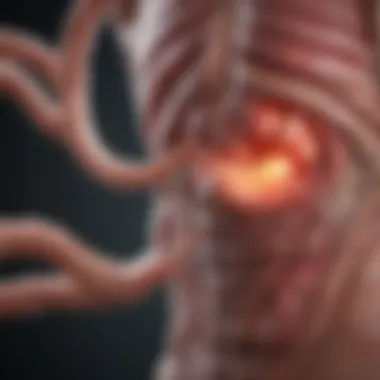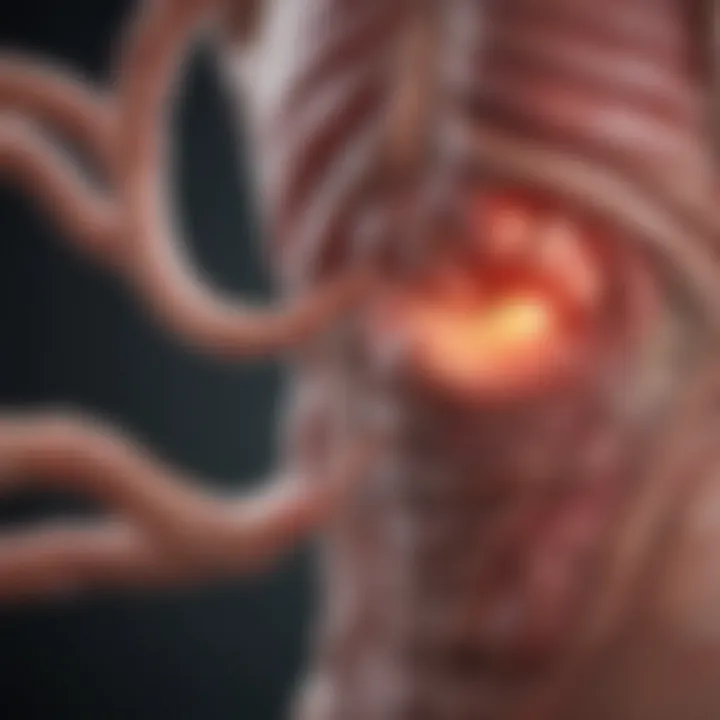Infection in the Intestinal Tract: Causes and Management


Intro
Infections that take place in the intestinal tract can greatly impact our health, yet they often fly under the radar. Not only do they affect our digestion, but they can also have rippling effects on our overall well-being. Understanding these infections—what causes them, how they operate, and the ways we can manage them—is crucial for anyone delving into the realm of gastrointestinal health.
A strong grasp on these factors can empower healthcare professionals, researchers, and even everyday people to identify and mitigate such infections more effectively. As we peel back the layers, we see that a variety of pathogens can wreak havoc in our intestines, from bacteria like Escherichia coli to parasites or viruses. This interplay of different infectious agents connects intricately with poor dietary habits, hygiene practices, and even environmental factors.
As we navigate through the complexities of this topic, we will explore the core aspects of intestinal infections, unpack their mechanisms of action, and indicate avenues for management—each component shedding light on an aspect that affects millions worldwide.
Research Overview
Summary of Key Findings
The research on intestinal infections reveals a wealth of information, significantly altering our understanding and management techniques:
- Diverse Pathogens: The intestinal tract hosts a myriad of microorganisms, and the pathogenic ones can disrupt normal functionality.
- Microbiome's Role: A balanced microbiome often enhances resistance to infections, while an imbalance may predispose individuals to various diseases.
- Symptoms and Diagnosis: Common symptoms like diarrhea, abdominal pain, and fever often signal an underlying infection and warrant timely investigation.
- Management Strategies: Treatment varies based on the pathogen involved and may include antibiotics, dietary adjustments, or even advanced therapeutic measures.
Importance of the Research
Understanding these infections isn't just academic; it's vital for real-world application. With rising resistance to antibiotics and emerging pathogens gaining a foothold, knowing how to manage infections effectively can save lives. Moreover, the implications of these findings extend beyond individual health, influencing public health policies and education as well.
Methodology
Study Design
To frame our understanding, a systematic approach was taken, examining both controlled studies and observational data across various demographics. This inclusive design allows for a comprehensive view of how infections manifest in different populations and settings.
Data Collection Techniques
Data was gathered through a mix of retrospective analyses, clinical trials, and surveys. Techniques allowed for capturing a holistic view of the situation:
- Surveys of Symptoms: Patient-reported outcomes shed light on the common experiences of those afflicted.
- Laboratory Analyses: Testing for specific pathogens provides concrete evidence of infections.
- Case Studies: Detailed examinations of identified cases contribute deep insights into the complexity of treating intestinal infections.
By synthesizing this information, we aim to create a resource that is both informative and practical, offering a pathway for better management of intestinal infections. As we explore further, we'll uncover the mechanisms behind these infections and the latest treatment modalities that hold promise for improving gastrointestinal health.
Prologue to Intestinal Infections
Intestinal infections are often brushed aside as minor inconveniences. However, they hold significant implications not only for individual health but also for public health systems globally. Understanding these infections is crucial because they can manifest in diverse ways, from mild discomfort to severe, life-threatening conditions. In an era where antibiotic resistance looms large, discerning the nuances of how these infections arise and progress can help in crafting better management strategies, equipping healthcare professionals with the right tools to combat them effectively.
Defining Intestinal Infections
Intestinal infections refer to a broad spectrum of illnesses caused by various infectious agents, including bacteria, viruses, parasites, and fungi that invade the gastrointestinal tract. These infections typically result from the ingestion of contaminated food or water, but they can also spread through person-to-person contact, highlighting the importance of hygiene practices.
From a clinical perspective, an intestinal infection can involve different sites within the gastrointestinal tract, leading to manifestations like diarrhea, vomiting, and abdominal pain. Understanding these definitions is not just an academic exercise—rather, it forms the backbone of clinical diagnosis and treatment strategies. This is particularly relevant in regions where sanitation may be compromised, making the population vulnerable to outbreaks.
Overview of the Gastrointestinal Tract
The gastrointestinal tract is a remarkable system, intricately designed to digest food, absorb nutrients, and eliminate waste. It begins at the mouth and extends through the esophagus, stomach, small intestine, large intestine, and finally exits through the rectum. Each segment plays a distinct role in digestion and absorption. The lining of these organs is fortified with a complex array of cells that can either facilitate or hinder the entry of infectious agents.
Moreover, the gut is home to trillions of microorganisms, collectively known as the gut microbiota. These microbes can influence not just digestion but also immunity and overall health. A disruption in this delicate balance can lead to dysbiosis, creating a breeding ground for pathogens. Understanding the gastrointestinal tract's anatomy and function is essential in grasping how infections can develop and affect bodily functions.
"The gut is often referred to as the body's second brain, reflecting its significant role not just in digestion but in overall health and wellness."
Conclusion of Intro
In summary, the introduction to intestinal infections sets the stage for a deeper dive into their causes, mechanisms, and management. Recognizing these infections' potential severity and understanding the gastrointestinal tract's complexity is vital for anyone interested in medicine, public health, or simply the mechanics of human health. This foundational knowledge not only enriches academic inquiry but also informs practical approaches to preventing and managing infections that affect millions each year.
Types of Infectious Agents
Understanding the different types of infectious agents is vital as they directly affect the intestinal tract's health. Each type—bacteria, viruses, parasites, and fungi—operates uniquely, leading to a variety of illnesses and complications. By exploring these agents, we can better appreciate their individual roles and the ways in which they contribute to health or disease. This section sheds light on critical characteristics and mechanisms of each infectious agent, setting the stage for deeper discussions on their pathophysiology and management strategies.
Bacterial Infections
Common bacterial pathogens
Bacterial infections in the intestine are often dominated by pathogens like Escherichia coli, Salmonella, and Campylobacter. Each of these bacteria presents unique threats, causing conditions ranging from mild gastroenteritis to severe systemic infections. The resilience of these pathogens plays a significant role in their prominence; for instance, E. coli has various strains, some of which can produce toxins that lead to serious health complications. Understanding these bacterial agents is beneficial as it can help in developing targeted treatment strategies and preventive measures. Their diverse characteristics also shed light on the importance of maintaining a balanced gut microbiota, as certain pathogenic bacteria can disrupt homeostasis.
Mechanisms of bacterial infection
Bacteria infect the intestinal tract through several mechanisms, such as adherence, invasion, and toxin production. Salmonella, for instance, utilizes invasion to penetrate intestinal cells, leading to inflammation and diarrhea. This mechanism is key in its success as a pathogen. These unique features highlight the complexity of bacterial infections and how different strategies can lead to varied clinical outcomes. Understanding these mechanisms allows researchers and healthcare providers to devise effective treatment protocols, though it may also present challenges in managing infections, particularly when antibiotic resistance comes into play.
Viral Infections


Leading viral agents
Viral infections, primarily caused by agents such as Norovirus and Rotavirus, can significantly disturb intestinal function. These viruses are highly contagious and can spread rapidly, especially in closed environments like nursing homes or schools. Their meticulous design—evading immune responses and causing widespread cell damage—makes them interesting subjects within our article. The advantage of focusing on viral agents lies in their unique transmission methods and the potential for large outbreaks, which can give insight into preventive measures that can be taken to protect vulnerable populations.
Pathophysiology of viral infections
The pathophysiology of viral infections involves a disruption of normal intestinal function, often leading to symptoms like vomiting and diarrhea. For instance, Rotavirus infects and destroys the epithelial cells of the intestine, causing severe dehydration. The understanding of how these viruses manipulate host cells and evade immune detection provides significant insight into potential target sites for antiviral treatments, although the challenge of developing effective long-term solutions remains. This complexity illustrates the need for ongoing research into various treatment modalities.
Parasitic Infections
Types of intestinal parasites
Parasitic infections often come from organisms like Giardia lamblia, Entamoeba histolytica, and tapeworms. Each type presents unique challenges, affecting nutrient absorption and overall gut health. Understanding the types and habits of intestinal parasites can significantly support the development of better management strategies. The key characteristic of these parasites is their life cycle, which often includes both human and environmental stages. These unique features necessitate educational efforts on hygiene and sanitation, important aspects in managing public health.
Impact of parasitic infections
Parasitic infections can lead to a range of symptoms, from mild diarrhea to severe malnutrition. Their impact on the population extends beyond the affected individuals, as they can have implications for public health resources and policies. Large-scale outbreaks of organisms like Giardia can strain healthcare systems. Moreover, the social implications, such as stigma and economic burden, cannot be overlooked. Thus, better knowledge of how these parasites operate can help tailor interventions that reduce their prevalence and impact.
Fungal Infections
Role of fungi in intestinal health
Fungi, including Candida species, play a dual role in the gastrointestinal tract. While they are part of the normal microbiome, overgrowth can lead to opportunistic infections. Their role in maintaining homeostasis is crucial; a balanced fungal population can help control pathogenic bacteria. The complexity of fungi’s interactions with other microorganisms in the gut flora is a critical area of study that informs how we view gut health. Understanding this balance allows healthcare providers to develop better approaches for managing dysbiosis and fungal overgrowth.
Fungal infection mechanisms
Fungal infections often occur when mucosal barriers are compromised, typically due to factors such as antibiotic use, underlying health conditions, or weakened immune systems. The mechanisms through which fungi invade and persist in the gastrointestinal tract highlight the importance of the microbiome’s integrity. Recognizing these mechanisms is essential for prevention strategies and can pave the way for the development of antifungal therapies. However, the challenges of resistance to treatment illustrate the complexity of managing fungal infections in clinical settings.
Pathophysiology of Intestinal Infections
Understanding the pathophysiology of intestinal infections is crucial for grasping the complexity of these conditions. This section illuminates the journey of how infectious agents gain entry, interact with host defenses, and affect the gut microbiota. Delving into these insights not only sheds light on the mechanisms of disease but also informs effective management strategies that can halt the progression of infections and improve patient outcomes.
Entry and Colonization
The entry point for various pathogens often begins at the mouth, where food and fluids may carry harmful microorganisms into the gastrointestinal system. This initial contact is key; the intestinal tract is designed to be a barrier against these intruders, but many pathogens have evolved clever techniques to breach this line of defense.
Common routes of entry include:
- Oral ingestion: This is where many pathogens are introduced, such as viruses in contaminated food or drinks like rotavirus or norovirus.
- Fecal-oral route: Particularly pertinent in cases of bacterial infections such as Salmonella or E. coli, where poor hygiene practices can allow the inadvertent ingestion of fecal matter containing pathogens.
Once inside, these pathogens must colonize the gut to establish an infection. Bacteria, for instance, often employ surface proteins and adhesins to anchor themselves to intestinal epithelial cells, while viruses might utilize receptors specific to human gut cells. This colonization phase not only increases the pathogen's chances of survival but also gives it leverage to release toxins or hijack normal cellular processes, leading to symptoms and further complications.
Immune Response Mechanisms
The immune system plays a pivotal role in defending the body against intestinal infections. When pathogens invade, the body activates a series of immune responses, both innate and adaptive, to thwart their spread. The innate immune reactions are typically the first line of defense, involving:
- Physical barriers: The epithelial lining of the gut acts as a physical blockade.
- Secretory IgA: This antibody is crucial in neutralizing pathogens, preventing them from binding to gut cells.
- Mucosal immunity: Specialized cells like Paneth cells produce defensins that directly kill bacteria.
On the other hand, the adaptive immune response engages later, creating a more robust defense. This includes T-cells that target infected cells and B-cells that produce high-affinity antibodies. However, in certain circumstances, such as during overwhelming infections or in immunocompromised individuals, this immune response can be insufficient. The result may be persistent infections, chronic inflammation, or even autoimmune reactions if the immune system malfunctions and starts attacking the host tissues.
Impact on Gut Microbiota
The human gut is home to trillions of microorganisms, collectively known as the gut microbiota, which play crucial roles in digestion, immune function, and synthesis of vitamins. An infection can severely disrupt this delicate balance, leading to dysbiosis—a state of microbial imbalance that can have far-reaching consequences.
Some potential impacts include:
- Reduction in diversity: Many pathogenic infections are associated with a noticeable decrease in microbial diversity, which correlates with poorer health outcomes.
- Increased pathogenic bacteria: As beneficial bacteria diminish, harmful bacteria can thrive more easily.
- Production of harmful metabolites: Altered gut microbiota can lead to increased production of toxic metabolites.
Restoring microbial balance post-infection is vital for gut health and overall well-being. Strategies for recovery might include dietary adjustments, probiotics, and prebiotics that support the recolonization of beneficial microbes. In this light, understanding the interplay between infection, immunity, and microbiota is foundational in developing effective treatments.
"The ability to understand and manipulate gut microbiota provides an exciting potential avenue for enhancing patient responses to treatment and recovery from intestinal infections."
Clinical Manifestations
Understanding clinical manifestations of intestinal infections is pivotal for several reasons. Firstly, these manifestations offer the first clues to healthcare providers about potential infections, influencing their diagnostic approach. Accurate identification of symptoms can lead to timely treatment, preventing complications and improving patient outcomes.
Moreover, recognizing the spectrum of clinical symptoms aids in tailoring management strategies. For instance, distinguishing between mild and severe symptoms helps clinicians determine the level of intervention needed. Awareness of these manifestations not only assists in effective patient care but also enhances the understanding of disease impact within the broader context of gastrointestinal health.
Common Symptoms
The symptoms of intestinal infections can widely vary, but some common ones serve as key indicators. They often present within a short timeframe after exposure to infectious agents. Notably, diarrhea stands out as a primary symptom, ranging from mild to severe. It can be watery or bloody, often accompanied by cramping or abdominal pain. In cases of bacterial infections like those caused by Escherichia coli or Salmonella, this symptom may appear rapidly.


- Nausea & Vomiting: Many patients experience discomfort, often leading them to lose appetite. This symptom can be particularly distressing, contributing to dehydration.
- Fever: A systemic response to infection, fever can indicate the body's attempt to fight off the invading pathogens. The presence of fever can vary significantly, from low-grade to high.
- Abdominal Pain: Cramping is common, often stemming from inflammation or irritation of the intestinal lining. Depending on the specific infection, the pain may localize or be diffuse.
- Fatigue & Weakness: As the body's immune system combats the infection, patients frequently report unusual tiredness, which may last for some time even after other symptoms resolve.
In an individual’s diagnostic journey, recognizing these symptoms is essential. They can serve as initial warning signs, oftentimes prompting further clinical assessment and laboratory investigations.
Severe Complications
While many intestinal infections resolve without major issues, severe complications can arise, particularly in vulnerable populations such as the elderly, immunocompromised individuals, or those with preexisting health conditions.
One significant complication that can result from severe infections is dehydration. This occurs when patients lose excessive fluids through diarrhea and vomiting. In extreme cases, dehydration may lead to kidney failure or shock, requiring urgent medical intervention.
- Intestinal perforation: Some bacterial infections can cause the intestinal wall to erode, leading to perforation. This is a surgical emergency, as it can result in peritonitis, a life-threatening condition.
- Sepsis: When the infection proliferates excessively, bacteria can enter the bloodstream, leading to systemic infection. Sepsis can affect multiple organs and demands immediate treatment.
- Post-infectious Irritable Bowel Syndrome (IBS): After resolution of infection, some may experience lasting digestive issues that manifest as IBS, causing persistent abdominal pain, bloating, or irregular bowel habits.
Understanding these potential complications emphasizes the importance of early detection and appropriate treatment for intestinal infections. Awareness helps patients and healthcare professionals alike take preventive steps when faced with symptoms of an intestinal infection.
"The clinical manifestations of intestinal infections are not merely symptoms but signals of the body’s response to invaders, guiding clinicians toward appropriate interventions."
Ultimately, a thorough understanding of clinical manifestations is crucial for improving gastrointestinal health. They serve as an intricate link between initial symptoms, potential complications, and ultimately effective management strategies.
Diagnosis of Intestinal Infections
Diagnosing intestinal infections is a pivotal part of managing gastrointestinal health. The accuracy of diagnosis directly influences the effectiveness of treatment regimens. In this intricate landscape, early detection can spell the difference between simple outpatient care and severe interventions. A comprehensive approach to diagnosis demands that medical professionals utilize both clinical assessments and laboratory testing. This dual-faceted strategy allows for a broader understanding of the infection’s nature and the most suitable treatment protocols.
Clinical Assessment
Clinical assessment serves as the first line of defense in diagnosing intestinal infections. Health care providers start with a thorough medical history, paying special attention to recent travel, dietary habits, and health conditions. These factors help in painting a picture of the patient’s situation.
During the physical examination, doctors often look for signs of dehydration, abdominal tenderness, and fever, which could indicate the severity of the infection. Symptoms such as diarrhea—often accompanied by the presence of blood or mucus—are scrutinized closely.
A skilled clinician's intuition is invaluable here. They may also probe into family medical history and previous infections to align symptoms with plausible causes. The key is to recognize patterns that could guide further diagnostic action, setting the stage for more in-depth laboratory investigations.
Laboratory Testing
Stool cultures
Stool cultures stand out as a cornerstone in diagnosing many intestinal infections. This method involves isolating pathogens from fecal samples, providing vital insights into the specific infectious agent at play. Unlike some other diagnostic techniques, stool cultures can detect a broad range of bacteria, fungi, and parasites, making them particularly useful in uncertain cases.
One significant characteristic of stool cultures is their specific ability to differentiate between various pathogens. This precision is invaluable in guiding appropriate treatment options. Moreover, because stool cultures assess actual samples from the point of infection, they deliver direct evidence rather than relying on symptoms alone.
However, there are also disadvantages. The process can be time-consuming, sometimes taking days for results. Additionally, evaluating the sensitivity of the cultured organisms may require further tests, such as antibiotic susceptibility testing.
Serological tests
Serological tests provide a complementary approach to stool cultures by measuring the immune response to specific pathogens. They detect antibodies or antigens in the blood, offering insights into ongoing or past infections. One remarkable feature of serological tests is their ability to identify infections when stool samples may not yield clear answers, especially in cases of viral infections like rotavirus.
The appeal of serological tests also lies in their relatively quick turnaround time. Results can often be returned in a matter of hours, allowing for timely adjustments in treatment plans. Nevertheless, these tests are not without limitations. False positives and negatives can occur, which may lead to misdiagnoses and inappropriate treatments. Additionally, their reliance on the individual’s immune response can complicate matters—if the response is weak, the test might not detect the infection.
“The art of diagnosis, much like medicine itself, hinges on understanding the entire patient, not merely the symptoms presented.”
Management Strategies
When it comes to tackling infections in the intestinal tract, management strategies play a pivotal role. The multifaceted nature of these infections emphasizes the necessity for a tailored approach, encompassing different techniques to accommodate varied situations. It’s not just a matter of treating the symptoms; rather, it’s about addressing the underlying causes while ensuring the patient’s overall well-being. The management strategies extend from antimicrobial treatments to supportive care and even alternative therapies, each carrying its own weight in the overall battle against intestinal infections.
Antimicrobial Treatment
Antimicrobial treatment forms the backbone of addressing bacterial and certain viral infections in the intestines. The primary objective here is to eliminate the infectious pathogens quickly to mitigate the escalation of symptoms and prevent complications. Common antimicrobial agents such as ciprofloxacin and metronidazole are popular choices among healthcare providers. However, it's crucial to tread carefully, as misuse or over-prescription of these medications can lead to antimicrobial resistance, complicating future infections. Thus, the selection of an appropriate antimicrobial must take into account the specific pathogen involved, its susceptibility profile, and the patient’s individual health circumstances.
Supportive Care
Supportive care is indispensable for patients battling intestinal infections. It aims to alleviate symptoms, provide relief, and enhance recovery without directly targeting the pathogens.
Hydration Techniques
Hydration techniques are often considered a cornerstone of supportive care, especially in cases characterized by diarrhea and vomiting. The loss of fluids can lead to dehydration, which poses severe risks to overall health. Oral rehydration solutions, which typically include a balance of salts and sugars, can be remarkably effective in maintaining fluid and electrolyte balance. The simplicity of these techniques, combined with their proven efficacy, has made them a go-to option in many clinical settings. One unique feature of these protocols is their capability to be administered at home, thus providing immediate assistance before professional medical care is available. However, while effective, these techniques may not suffice for severe cases requiring intravenous fluids where quick absorption is crucial.
Nutritional Support
Nutritional support plays an equally important role, aiding in recovery while also addressing the body's increased metabolic demands due to the infection. A well-balanced diet tailored to the patient’s specific needs is crucial during this time. Emphasizing easily digestible foods, like bananas and rice, helps in replenishing lost nutrients while minimizing gastrointestinal stress. Additionally, fortified nutritional beverages can offer essential vitamins and minerals in a concentrated form, making them an appealing choice. One key aspect of this support is that it not only aids in recovery but also helps in restoring gut health. However, one must be careful with food choices, as certain foods may exacerbate symptoms, complicating the recovery process.
Alternative Therapies
Alternative therapies are gaining traction as adjuncts to traditional management strategies for intestinal infections. They present options that may ease symptoms and provide additional support to the gastrointestinal system.


Probiotics and Prebiotics
Probiotics and prebiotics are often discussed in the realm of gut health. Probiotics—live microorganisms—can enhance gut flora, thereby potentially combating the disruptive effects of infections. On the other hand, prebiotics are non-digestible food components that foster the growth and activity of beneficial bacteria. The duo can serve as a helpful ally in promoting recovery and restoring balance in the gut microbiome. Their popularity stems from their relatively low side-effect profile and the flexibility in administration; they can be incorporated into daily diets without too much fuss. However, it’s essential to highlight that effectiveness can vary, and those with severe infections might not experience rapid benefits.
Phage Therapy
Phage therapy represents an intriguing alternative, focusing on the application of bacteriophages—viruses that specifically target bacteria. This method is particularly promising in the face of rising antimicrobial resistance. Unlike conventional antibiotics, phages selectively destroy harmful bacteria without disturbing the overall microbiota, making them an attractive choice for targeted treatment. Their unique feature lies in their specificity; they are tailored to match specific pathogens, thus reducing collateral damage to beneficial microbes. However, phage therapy is still in its infancy, requiring further research to address potential challenges, such as immune responses and the stability of phages during treatment.
Preventative Measures
Preventing intestinal infections is not just a mere afterthought, but a cornerstone in maintaining overall gastrointestinal health. With the growing prevalence of such infections due to various factors, understanding preventative measures becomes essential. These strategies can significantly reduce the risk of infection, impacting both individual well-being and public health at large. Here, we delve into the critical components of effective prevention, placing a spotlight on hygiene practices, food safety guidelines, and advancements in vaccination.
Hygiene Practices
Maintaining proper hygiene practices plays a crucial role in thwarting the onset of intestinal infections. Simple habits can lead to substantial preventive outcomes. Handwashing with soap and water before meals and after using the restroom is one of the most effective actions individuals can take. This habit can eliminate a plethora of harmful pathogens that might be lurking on our hands. Children, in particular, benefit from education regarding proper hygiene practices, as they are often more susceptible to infections due to their developing immune systems.
- Use soap and warm water: Rubbing hands together for at least 20 seconds is a must.
- Hand sanitizers: When soap and water aren't available, hand sanitizers with at least 60% alcohol can reduce germs.
- Surface sanitation: Regularly cleaning surfaces, especially in kitchens and bathrooms, can prevent cross-contamination.
Moreover, encouraging good hygiene in community settings such as schools, daycares, and public areas helps in minimizing spread. The importance of hand hygiene extends to food preparation practices, which is oftentimes underestimated.
Food Safety Guidelines
The food we consume can be a gateway for intestinal infections. Thus, adherence to strict food safety guidelines is neither trivial nor optional. It’s about ensuring that the food we put on our plates is safe and clean. Here are key practices to consider:
- Proper cooking: Cooking food to the right temperature kills harmful microorganisms. For instance, poultry should reach an internal temperature of 165°F (75°C).
- Avoid cross-contamination: Using separate cutting boards for meats and vegetables can reduce the chance of germs transferring from one to the other.
- Refrigeration: Storing perishables below 40°F (4°C) delays bacterial growth. Leftovers should be consumed or discarded after three days to limit risk.
Following these guidelines isn’t just about enjoying meals safely; it’s also about fostering a culture of health security. Public education campaigns emphasizing food safety have proven beneficial in reducing infection rates in various communities.
Vaccination Developments
In the battle against intestinal infections, vaccines represent a potent tool. While hygiene and food safety can mitigate risks significantly, vaccination can provide an additional line of defense. The development of vaccines targeting specific pathogens responsible for gastrointestinal infections has been a landmark achievement in public health. Here are a few notable aspects:
- Current vaccines: Vaccines for rotavirus, which can cause severe diarrhea in children, have dramatically reduced hospitalizations.
- Research frontiers: Ongoing research aims to create vaccines for other pathogens like E. coli and Campylobacter. These agents are notorious for causing foodborne illnesses and could become part of routine immunization schedules in the future.
- Barriers and solutions: Vaccine hesitancy remains a challenge. Addressing public misconceptions and providing reliable information is critical in fostering acceptance.
"Investing in vaccination strategies can determine the future trajectory of gastrointestinal health, especially in vulnerable populations."
As we move forward, understanding and implementing these preventative measures is essential in the quest to minimize intestinal infections. Continued education and awareness can empower individuals and communities to take proactive steps towards safeguarding health.
Emerging Research and Trends
Emerging research in the realm of intestinal infections is crucial as it sheds light on novel diagnostic methods and innovative treatment strategies that could significantly alter how these infections are managed. In an age where antibiotic resistance poses a formidable challenge, efforts to pinpoint alternative treatment methods are gaining traction.
Breakthroughs in Diagnosis
Recent advancements in diagnostic techniques have enhanced the ability to identify various pathogens responsible for intestinal infections. One notable technique includes next-generation sequencing, which allows for the rapid identification of microorganisms present in a patient’s stool sample. This method is not only more sensitive but can also identify multiple pathogens in a single test, providing a comprehensive view of the infection.
Moreover, the development of biomarker-based assays is showing promise. These biomarkers can indicate the presence of infection even before clinical symptoms arise, paving the way for early intervention. Detecting pathogens in this manner offers a two-fold benefit: it can hasten the initiation of appropriate treatment and curb the unnecessary use of broad-spectrum antibiotics, thus countering resistance trends.
"Timely and accurate diagnosis is half the battle won against infections in the intestinal tract."
Furthermore, advancements in mobile health technologies are enabling remote diagnostics, allowing patients to receive guidance and treatment from the comfort of home. This trend not only increases accessibility but also encourages individuals to seek help sooner rather than later.
Future Treatment Modalities
As the field of intestinal infections evolves, so do the treatment modalities. One of the most exciting areas of research includes the use of phage therapy. This approach entails using bacteriophages—viruses that specifically target bacteria—to combat bacterial infections. With studies demonstrating promising results against resistant strains, phage therapy could soon complement or even replace conventional antibiotics in specific cases.
Additionally, immunotherapy is emerging as a method to bolster the body’s immune response against infections. By enhancing the immune system’s ability to recognize and combat pathogens, immunotherapy could potentially revolutionize the way intestinal infections are treated.
The exploration of microbiome modulation, including probiotics and dietary interventions, holds considerable potential too. By understanding how gut flora influences health, researchers are investigating ways to restore or enhance beneficial bacteria, potentially preventing or ameliorating infections.
Another key focus area is the interdisciplinary approach combining therapies with nutrition. Ensuring proper nutrition throughout treatment could improve recovery rates and response to therapies. Thus, the integration of nutrition science into treatment plans signals a noteworthy shift towards holistic patient care.
Epilogue
As we draw the curtain on our in-depth examination of intestinal infections, it's crucial to underscore the significance of understanding this multifaceted topic. Intestinal infections pose a considerable threat to health, impacting individuals worldwide and placing a substantial strain on healthcare systems. By delving into the causes and mechanisms of these infections, we not only shine a light on their clinical implications but also equip ourselves with the knowledge necessary for effective management and prevention.
Key Takeaways
- Complexity of Infections: Intestinal infections are driven by an array of infectious agents, including bacteria, viruses, parasites, and fungi, each operating through distinct mechanisms.
- Recognition of Symptoms: Early recognition of symptoms is vital for timely diagnosis and treatment. Symptoms can vary significantly, from mild gastrointestinal discomfort to severe, life-threatening conditions.
- Importance of Management: Employing appropriate management strategies, such as antimicrobial treatments and supportive care, is essential in mitigating the impacts of infections.
- Preventative Measures: Adopting strict hygiene practices, food safety guidelines, and vaccination can significantly reduce the risk of infection.
- Emerging Trends: Continuous research into innovative treatment modalities and diagnosis is vital for addressing the ever-evolving nature of pathogens.
Importance of Continued Research
The landscape of intestinal infections is continually shifting, with new pathogens emerging and existing ones evolving. Continued research holds paramount importance for several reasons:
- Adaptation and Resistance: As infections adapt over time, understanding their evolving mechanisms is crucial for developing effective treatments. Research can help identify patterns of resistance and inform new therapeutic strategies.
- Enhanced Diagnosis: With advancements in technology, the potential for more precise diagnostic tools is expanding. Investagating new methodologies can lead to prompt identification of infections, reducing the risk of complications.
- Tailored Treatments: Insights gained from ongoing studies could facilitate personalized medicine approaches, wherein treatments are tailored to individual patient needs and infection profiles.
- Public Health Implications: Research not only informs clinical practices but also shapes public health policies. A deeper understanding of infection dynamics can lead to more effective community health interventions.
In summary, as we stand at the crossroads of existing knowledge and future possibilities, the importance of continued research in understanding and managing intestinal infections cannot be overstated. It is through these scholarly pursuits that we can aim to protect and improve gastrointestinal health on both individual and population levels.



